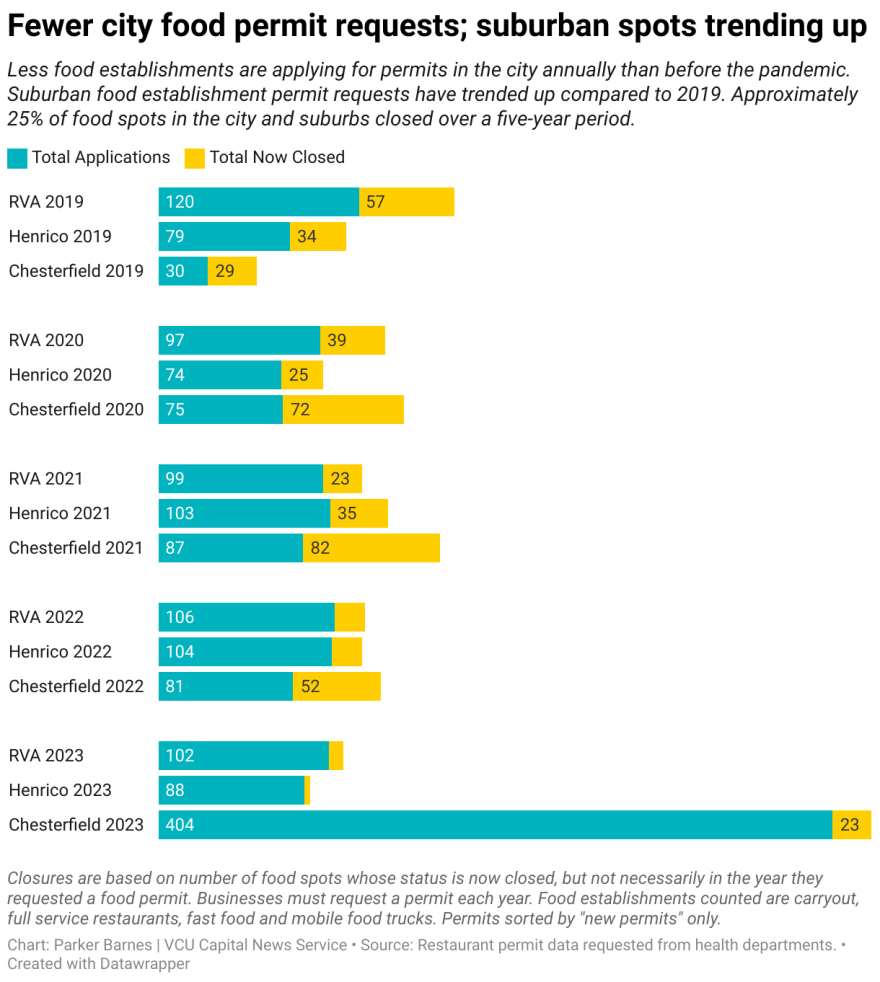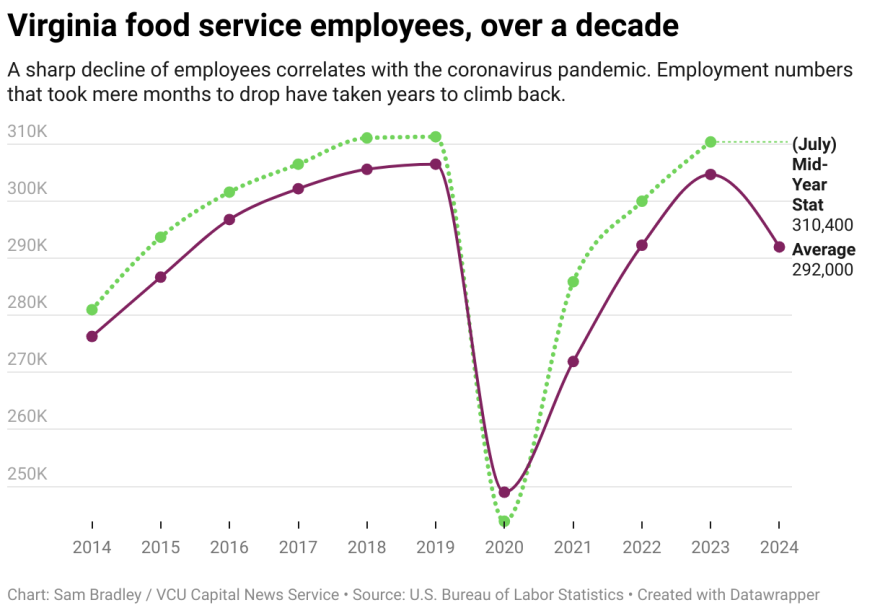The owner of Tarrant’s Cafe in downtown Richmond is a 20-year veteran of the city’s food scene. She started out waiting tables — and now owns four Richmond-area restaurants and is the CEO of RVA Hospitality.
Liz Kincaid maintains her urban locations, And Dim Sum, Tarrant’s and Bar Solita, but she’s also expanded into the Henrico County suburbs with Tarrant’s West.
“Compared to my downtown restaurants, it's more successful with sales, its guest counts are higher, people are more willing to go out there,” Kincaid said.
The restaurant industry experienced significant technology and operational changes since the beginning of the COVID-19 pandemic. Restaurant owners reconsidered their location in proximity to customers — and in the face of rising costs and evolving consumer choices.
In recent years, nearby suburban markets have competed with the city’s nationally recognized culinary scene. The number of food permit requests has decreased in the city when compared to pre-pandemic numbers. Meanwhile, food permits in suburban Henrico and Chesterfield counties have trended up compared to 2019, according to data from the Virginia Department of Health.

Both Tarrant’s locations have the same menu, so parking and meals taxes are two factors customers might consider when they choose which location to dine at, according to Kincaid.
Richmond charges a 7.5% meals tax on all tabs collected within city limits, while Henrico’s tax is 4%. Both collect a 6% local sales tax.
That means any item purchased in Richmond is taxed at 13.5% once the bill hits the table.
A beer in Henrico isn’t considered a meal, whereas the same customer’s beer in Richmond would be subject to the meals tax.
Nearby Chesterfield does not have a meals tax. It recently celebrated its first restaurant week to showcase local eateries.
Market impacts
Richmond’s dining scene took a hit during the pandemic as more office employees began, and continued, to work from home.
“We used to do a lot of catering, our lunch business was really thriving,” Kincaid said. “It was 30% of our sales at Tarrant’s Cafe and it’s just never returned. We just don’t have enough people down here in the office to maintain that.”
Food service employees do not have remote work options, which posed a unique problem during lockdowns, according to Eric Terry, president of the Virginia Restaurant Lodging & Travel Association.
At least 67,000 fewer Virginia employees worked in the food and beverage industry in July 2020, compared to the previous year. That's an almost 22% drop, based on U.S. Bureau of Labor Statistics data. Employment numbers that took months to drop have taken years to climb back.

Washington, D.C., business owners have similarly cited a slow return of in-person government work, according to a report by Restaurant Business.
Closures have resulted in 3,700 industry jobs being lost in the district, according to Terry.
“We also had closure of a restaurant a week in Washington, D.C.,” he said.
The district recently passed legislation to change the tip credit system, which allows employers to pay below the minimum wage if tips cover the difference. The base wage for restaurant workers in the district will be raised in July to $10 an hour, plus tips. The base wage was previously $8. Minimum wage for nontipped workers is $17 an hour, which will increase by 50 cents in July.
Prices increased in almost all Washington-area restaurants following the pandemic, with an average menu price increase of 16%, according to data from the Restaurant Association of Metropolitan Washington. The increases followed higher wages and restaurant costs.
But increased menu prices could drive away customers, which then negatively impacts tips, Terry said.
“The way that the tipping world has been set up is that you, the consumer, pay the wages of the server,” Terry added.
Terry pointed to a price increase of “anywhere from 12% to 18%” to explain why Virginia restaurants have been able to keep doors open.
“Most restaurants are probably seeing their revenues about stable from before, but the customer counts are down,” Terry said.
Restaurants, customers try something new
The food industry had to pivot due to changes in labor, food selection and technology, according to Mahmood Khan, a Virginia Tech professor of hospitality and tourism management.
Many workers left the industry for other jobs and the workforce has only recently climbed near pre-pandemic counts. Many restaurant hours have changed, and employees have asked for more scheduling flexibility.
Workers also now earn more. Average hourly earnings for Virginia’s leisure and hospitality employees, which includes food services, bumped up to $18.93 last year, from $14.82 in 2019, according to data from the U.S. Bureau of Labor Statistics.
The pandemic also spurred innovations to the dining experience in an industry historically slow to adopt changes.
During the height of the pandemic, some restaurants gave out their recipes for quarantined chefs to cook themselves. Others sold groceries when they could, according to Khan.
And everyone pivoted to takeout.
Delivery services like DoorDash and Uber Eats have become ubiquitous. Restaurant designers now incorporate parking spaces for delivery drivers and shelves at the front of the store for food pickup.
Tips were “significantly sadder” for Amanda Philipp when Sheppard Street Tavern stopped dine-in service. A bartender in Richmond for 10 years, Philipp said patronage and tips have begun to return.
She hopes customers approach this return to normalcy with patience for the employees who provide food, drinks, care and hospitality.
“As long as we’re here, we’re still gonna be that smiling face,” Philipp said. “We’re your friends, we’re that face of humanity that hopefully will never go away.”
Richmond-area dining community
Customers responded to these changes with their wallets. Many are more conservative with their funds than before the pandemic, according to Robey Martin, a longtime local food writer.
“Discretionary dollars are not what they were,” Martin said.
Martin covers the food scene in Richmond and other areas of Virginia. She knows the industry’s challenges, ebbs and flows — as well as impact of the “relatively large food tax.”
“It’s killing our city restaurants,” Martin said. “It’s astronomical.”
Breweries and distilleries help support fledgling suburban markets, according to Martin. These offer spaces for new restaurant concepts to expand in the suburbs.
“Those have brought a lot of liveliness to the suburban areas,” Martin said. “It gives [people] a place you can gather, get food you wouldn’t normally get because it’s a food truck or a pop-up.”
Experienced chefs relocating beyond city limits are another boon to the suburbs, though the trend began before the pandemic.
Walter Bundy, former executive chef at Lemaire, opened Shagbark in 2016 in the midtown Libbie Mill area, just west of Richmond. Acacia Midtown — run by Richmond Restaurant Week founders Dale and Aline Reitzer — also opened outside of the city last year.

Michael Lindsey’s Lindsey Food Group opened Farm + Oak West End in Henrico late last year.
“He’s probably the largest Black-owned restaurant group on the East Coast,” Martin said. “He’s pushing some wonderful restaurants out into those areas that don’t often see local ownership.”
The experience is what it’s all about, regardless of location, according to Martin.
“It’s never, ever about the food — it is always about the companion,” Martin said. “It’s always about the service, and it’s always about what the memory is.”
Although there are some “burgeoning” suburban food scenes, Martin’s reviews don’t have as much impact beyond city limits, she said. The city is still hungry for the competition and the community it brings.
Richmond’s downtown restaurants have benefited from an increase in tourism in recent years, according to Kincaid, the restaurateur. Some of her business comes from out-of-towners visiting the nearby convention center and hotels.
Yet, Kincaid appreciates being part of a close-knit restaurant community. She's in an email chain with over 50 restaurant owners, where they ask for recommendations and count on each other for help, if needed.
“I don’t always see that in some of the bigger cities; it can be very competitive,” Kincaid said. “So, I think we’ve still got that small town mentality to help each other out.”
Capital News Service is a program of Virginia Commonwealth University's Robertson School of Media and Culture. Students in the program provide state government coverage for a variety of media outlets in Virginia.


